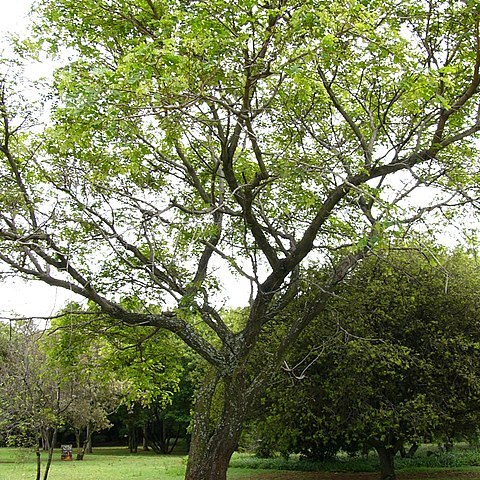Tree 5–15 m. high (to 20 m., fide F.C.B.), deciduous; crown spreading, ± flat; bark rough, greyish-brown.. Young branchlets densely rusty-tomentose.. Leaves: rhachis clothed like the young branchlets; pinnae 1–4 (–5) pairs; leaflets 3–6 pairs, broadly and obliquely obovate to suborbicular, sometimes broadly oblong, 14–63 mm. long, 12–49 mm. wide, rounded and mucronate to emarginate at apex, rarely subacute, becoming coriaceous, pubescent above, densely tomentose or pubescent beneath.. Flowers white to greenish-yellow; pedicels 0–2(–2.5) mm. long; bracteoles at flowering-time present or already fallen.. Calyx 4.5–7 mm. long, densely rusty-pubescent or-tomentose outside, not slit unilaterally.. Corolla clothed like calyx, 8–12 mm. long.. Staminal tube not or scarcely exserted beyond corolla; filaments 2.5–4.5 cm. long (to 5.5 cm. fide F.C.B.).. Pod oblong, 10–27 (–30 fide F.C.B.) cm. long, 3.2–6.5 cm. wide, glabrous (or with a very few hairs on stipe and margins only), ± glossy, obscurely venose, chestnut-brown or crimson.. Seeds about 9–13 mm. long and 8–11 mm. wide, flattened.
A tree. It grows 5-18 m high. The crown is flat and spreading. The bark is rough and greyish-brown. The young branches have a rusty covering. The leaves are compound. The leaflets are few and broad. There are 1-4 leaflet stalks and 3-6 pairs of leaflets along these. The leaflets are 2-6 cm long by 1-5 cm wide. They are broadly oval. They are very hairy underneath. The flowers are white to greenish-yellow. The fruit is a pod 10-27 cm long by 3-7 cm wide. The seeds are flattened and about 1 cm across.
Leaves: rhachis clothed like the young branchlets; pinnae 1-4(5) pairs; leaflets 3-6 pairs, 14-63(70) x 12-49(55) mm., broadly and obliquely obovate to subcircular, sometimes broadly oblong, rounded and mucronate to emarginate at the apex, rarely subacute, becoming coriaceous, pubescent above, densely tomentose or pubescent beneath.
Tree, up to 18 m high. Young branchlets densely rusty-tomentose. Mature leaflets broadly and obliquely obovate to subcircular, 15-67 x (10-) 15-45 mm, densely pubescent to tomentose beneath, in 2-5 pairs. Pods glabrous. Flowers creamy white.
Pod dehiscent, 10-27(30 fide F.C.B.) x 3.2-6.5 cm., oblong, glabrous (or with some hairs on the stipe and margins only), ± glossy, obscurely venose, chestnut-brown or crimson.
Tree (3)5-18(20) m. high, deciduous; crown spreading, ± flat or rounded; bark usually rough, greyish-brown; young branchlets densely rusty-tomentose.
Flowers white to greenish-yellow; pedicels 0-2(2.5) mm. long; bracteoles at flowering time present or already fallen.
Staminal tube not or scarcely exserted beyond the corolla; filaments 2.5-4.5 cm. long (to 5.5 cm. fide F.C.B.).
Calyx 4.5-7 mm. long, densely rusty-pubescent or-tomentose outside, not slit unilaterally.
Corolla clothed like the calyx, 8-12 mm. long.
Seeds c. 9-13 x 8-11 mm., flattened.


